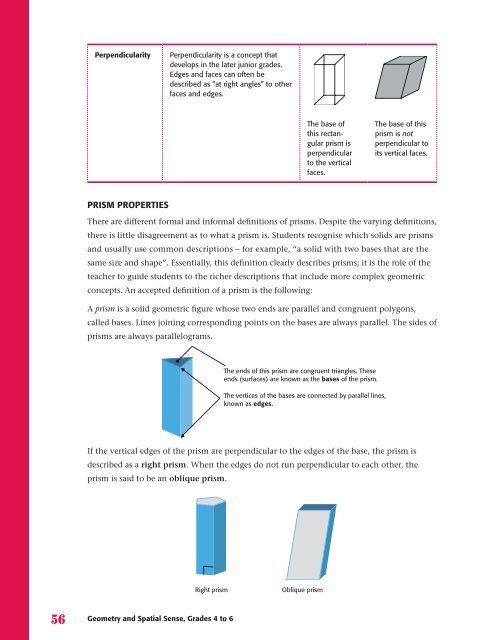Geometry and Spatial Sense, Grades 4 to 6 - EduGains
Geometry and Spatial Sense, Grades 4 to 6 - EduGains
Geometry and Spatial Sense, Grades 4 to 6 - EduGains
Create successful ePaper yourself
Turn your PDF publications into a flip-book with our unique Google optimized e-Paper software.
6<br />
Perpendicularity Perpendicularity is a concept that<br />
develops in the later junior grades.<br />
Edges <strong>and</strong> faces can often be<br />
described as “at right angles” <strong>to</strong> other<br />
faces <strong>and</strong> edges.<br />
PRISM PROPERTIES<br />
<strong>Geometry</strong> <strong>and</strong> <strong>Spatial</strong> <strong>Sense</strong>, <strong>Grades</strong> 4 <strong>to</strong> 6<br />
The base of<br />
this rectangular<br />
prism is<br />
perpendicular<br />
<strong>to</strong> the vertical<br />
faces.<br />
The base of this<br />
prism is not<br />
perpendicular <strong>to</strong><br />
its vertical faces..<br />
There are different formal <strong>and</strong> informal definitions of prisms. Despite the varying definitions,<br />
there is little disagreement as <strong>to</strong> what a prism is. Students recognise which solids are prisms<br />
<strong>and</strong> usually use common descriptions – for example, “a solid with two bases that are the<br />
same size <strong>and</strong> shape”. Essentially, this definition clearly describes prisms; it is the role of the<br />
teacher <strong>to</strong> guide students <strong>to</strong> the richer descriptions that include more complex geometric<br />
concepts. An accepted definition of a prism is the following:<br />
A prism is a solid geometric figure whose two ends are parallel <strong>and</strong> congruent polygons,<br />
called bases. Lines joining corresponding points on the bases are always parallel. The sides of<br />
prisms are always parallelograms.<br />
If the vertical edges of the prism are perpendicular <strong>to</strong> the edges of the base, the prism is<br />
described as a right prism. When the edges do not run perpendicular <strong>to</strong> each other, the<br />
prism is said <strong>to</strong> be an oblique prism.<br />
The ends of this prism are congruent triangles. These<br />
ends (surfaces) are known as the bases of the prism.<br />
The vertices of the bases are connected by parallel lines,<br />
known as edges.<br />
Right prism Oblique prism

















